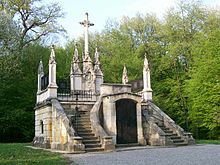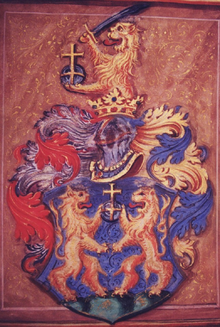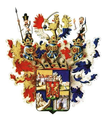Jelačić
The Jelacic of Bužim , even Jelacic de Bužim , ( Croatian Jelačići od buzima or Jelačići Bužimski ) are an ancient Croatian - Austrian noble family , which in 1797 into the baron and in 1855 in the rank of count was elevated.
Contemporary the name Jelačić appears to be spelled differently, namely as Jellačić , Jelacić , Jellachich or Jelacsics . The additional predicate Bužim became common in the 18th century. From the Bužim estate , it is first recorded for Franz (1746–1810) and his son, the most famous member of the family, the Croatian Ban Joseph Graf Jelačić (1801–1859), who always signed with Jellačić at the time .
history
The family of Croatian noblemen Jelačić comes from Slavonia . After the Hungarian-Croatian armies were defeated by the Ottomans on the Krbava in 1493 , the Croatian nobility was decimated and part of Croatia (now Slavonia) was occupied. Some members of the family subsequently converted to Islam and gained prestigious positions in the Ottoman Empire.
At the end of the 15th century, Antonius is attested as the oldest known bearer of the Roman Catholic family branch in northern Croatia. At the beginning of the 16th century, the Jelačić von Buzim - the branch of the family from which the later Banus descended - held their property on the Kupa and in Turopolje (Turkish field, also auroch field) near Agram (Zagreb) ; also Samobor in Zagreb was temporarily in their possession.
After the area was recaptured by Emperor Leopold I , the Jelačić served in the Austrian army for centuries. They played an important role, especially in the border regiments of the military border and the fight against constant raids on the border between Bosnia and Serbia . The first was the Serezan captain Albert Jelačić of Buzim.
Franz von Jelačić (1746–1810) wasawarded the Knight's Cross of the Military Maria Theresa Order in1797for the heroic defense of Feldkirch in Vorarlberg during the Napoleonic Wars and in 1799 was raised to the status of baron. He was married to Anna Freiin Portner von Höflein (* May 10, 1775, † November 28, 1837)since 1799.
His son Joseph, the Feldzeugmeister and Ban of Croatia, was awarded the Count's status by the highest resolution of Emperor Franz Joseph I with a diploma of July 12, 1855 and with the highest handwriting of May 26, 1859 and a certificate of confirmation from January 15, 1860 to his two brothers Anton and Georg transferred.
Personalities

- Joseph Graf Jelačić von Bužim (1801-1859), was kk major general (1848), then field marshal lieutenant (1848), and finally Feldzeugmeister (1849). MTO on June 29, 1849.
- Georg Anton Graf Jelačić von Bužim (1805-1901), was kk major general (1849), then field marshal lieutenant (1856).
- Anton Graf Jelačić von Bužim (1807–1875), was kk major general (1854). In 1859 he was honored with the field marshal lieutenant character ad honores.
The family members living today are all descendants of Field Marshal Lieutenant Franz Freiherr von Jelačić. Countess Luise Jelacic and her daughter Marie-Louise live in the USA . (As of December 2006) .
coat of arms
Historical coats of arms
Coat of arms of Count Jelacic ( regular coat of arms with three helmets that were granted 1808)
1579 : The sons of Marko (Markus) Jelačić, documented in 1551, received a letter of nobility from Emperor and King Rudolf II in 1579 for their services in the battles against the Ottoman Turks , namely Ivan (Johann), Juraj (Georg), Nikola (Nikolaus) , Petar (Peter) and Gabrijel (Gabriel), as well as their sister Ana (Anna). In the blue shield on a green three-mountain, it shows two facing golden lions, holding an imperial orb together, on the crowned stinging helmet with red and silver helmet covers on the right, blue and gold helmet covers on the left, a growing golden lion, with the right wielding a saber, in the left an imperial orb holding.
1614: The coats of arms granted in 1614 by Emperor and King Matthias to the same siblings, as well as the other brother Mihajl (Michael), who probably already died or possibly emigrated, expresses, like many contemporary coats of arms of other noble families in the region, in its now red shield anti - Ottoman propaganda , namely on a green three-mountain two facing two-tailed, crowned golden lions, which together hold a golden sword, on the tip of which is a Turkish head with a blue turban, over two Turkish heads with a blue turban lying on the ground. On the crowned temple helmet with blue and gold helmet covers on the right, red and silver helmet covers on the left, a growing crowned golden lion, swinging a saber with his right hand, holding an imperial orb in the left, between the open, red and silver from the right, blue and gold on the left (in other representations also of red and blue) split open flight .
1808 shield with a square and a heart shield. Heart shield: On a green ground a golden sword placed upwards in piles, on which a forward-facing Turkish head with a white turban and blue fez is attached, which is supported by two double-tailed, crowned and red-tipped lions standing up against each other. These are supported with their right hind paws on one of the two Turkish heads pushed onto the sword pommel, which are similar to the one described above. Field 1: in gold on green ground, the Achau fortress, field 2: in blue on green ground, Feldkirch Castle next to natural rocks, field 3: in blue between natural rocks in a ravine of the Luciansteig, field 4 in front of a golden ground a high, silver battlement wall with large gate between wall pillars (Zurich). On the shield with the barons crown three helmets: in the middle of the family coat of arms helmet, on the two outer ones a growing soldier, the right one with a lance and a rifle hanging around the neck, the left one with an oath hand and a rifle standing by foot.
1855, 1860: Field 1: In blue a silver crossbar, over which a golden sword is placed by stake (reminder of the Drau crossing in 1848);
2: in blue a Swiss mountain range on green ground, pushed towards the division, in the background a red church with two towers, to which a path leads diagonally (reminder of the scene where Count Joseph's father won the Maria Theresa Order: Feldkirch );
3: Also in blue, two rock walls rise from the foot edge, between which a red building on green ground, to which a path leads diagonally to the left and in the background an alpine mountains can be seen (reminder of Luziensteig , where Count Joseph Vater also distinguished himself );
4: like the others in blue, a crossbar made of red and silver in five transverse rows, accompanied by a silver star at the top and an upwardly directed silver crescent moon (the Croatian coat of arms, accompanied by the emblems of the star and crescent moon often found among the Croatian nobility ). The count's crown rests on the shield with three gold-crowned tournament helmets on top. From the crown of the middle one grows a double-tailed, crowned, red-tongued golden lion, in the opening of an eagle's flight to the right, red and gold, alternating transversely on the left, in the right front paw he swings a red saber above him, in the left he carries in front of him is a blue orb framed in gold (the original helmet decoration of Jelačić's coat of arms).
From the crowns of the right and left helmets grow a forward-facing man in black armor, the man on the right helmet with a closed visor, the helmet with a golden ostrich feather between two blue ones, with a golden sash over the right armpit, with one same sword hilt and belt, in his right hand holding a lance with a blue tassel, the left one on the hip. The man on the left helmet has his visor open, has a silver ostrich feather on his helmet between two blue ones, the sash and sword belt are silver, he holds his right hand in an oath, in his left a lance with a blue tassel. Helmet covers. Those of the middle helmet are underlaid with gold in red, those of the other two blue, on the right helmet with gold, on the left with silver. Motto. Under the shield there is a fluttering red ribbon, on which the motto adopted by the Banus when crossing the Drava: Što bog dade i sreća junačka (What God gives and hero's happiness ) is affixed in golden lapidary writing.
literature
- Walter Görlitz : Jelačić: Symbol for Croatia: The biography . Almathea, Vienna / Munich 1992, ISBN 3-85002-319-2 .
- Milan Turković: Antemurale Christianitatis: The former Croatian-Slavonian military border . 2nd Edition. Self-published, Sušak 1937.
- Biographical lexicon of the Austrian Empire
Web links
Individual evidence
- ↑ According to GHdA -Adelslexikon, Volume VI, Volume 91 of the complete series, Limburg an der Lahn 1987, p. 36 f.
- ↑ croatianhistory.net: Jelacic (accessed May 1, 2014)
- ^ Adolph Bornschein: Austrian Cornelius Nepos . Vienna 1812.
- ↑ Dr. J. Hirtenfeld: The military Maria Theresa order and its members . Vienna 1837.
- ↑ J. Hirtenfeld (Ed.): Austrian Military Conversation Lexicon . tape III . Vienna 1850.
- ↑ Biography nouvelle des Contemporains . Paris 1821. and see Librairie historique des hommes marquans de la fin du dix-huitième siècle etc . tape II . London 1800, p. 227 .
- ^ Walter Görlitz : Jelačić: Symbol for Croatia: The biography . Almathea, Vienna / Munich 1992, ISBN 3-85002-319-2 , p. 21 .
- ↑ Milan Turković-Kutjevski: Former Croatian-Slavonian Military Frontier . 1st edition. Self-published, Zagreb 1937, p. 190 f .
- ^ Glenn Jewison, Jörg C. Steiner: Austro-Hungarian Land Forces 1848–1918: Military Maria Theresia Order - I to L. Accessed on October 14, 2013 .
- ^ Antonio Schmidt-Brentano: The kk or kuk generality 1816-1918 . Ed .: Austrian State Archives. Vienna 2007 ( oesta.gv.at [accessed October 14, 2013]). The kk or kuk generals 1816–1918 ( Memento of the original from October 4, 2013 in the Internet Archive ) Info: The archive link was automatically inserted and not yet checked. Please check the original and archive link according to the instructions and then remove this notice.
- ↑ strain crest to GHdA -Adelslexikon, Volume VI, Vol 91 of the total number, Limburg f. An der Lahn, 1987, page 36, where according to the Blasonierung contain the emblem of 1808.







